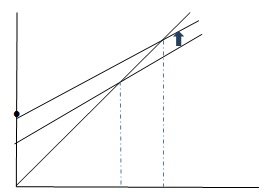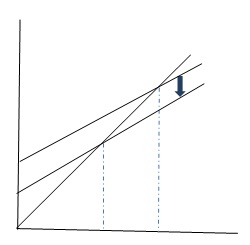Assignment:
Short Answer: Assume there are no income taxes and no imports. People spend 90 cents out of each additional dollar they earned.
i) Draw the aggregate expenditure curve and designate the equilibrium aggregate expenditure and real GDP.

ii) If government decided to increase the government spending by $1M, draw the change to the equilibrium aggregate expenditure and real GDP.

iii) Calculate the multiplier.
MPC = 0.9/1M
= 9.0*10^-7
Multiplier = 1/ (1- 9.0*10^-7)
=1/0.9999991
= 1.0000009
iv) Calculate the change (need to use multiplier) of real GDP due to a $1M increase in government spending.
Multiplier =1 /(1-Slope of AE curve)
1.0000009=1 /(1-Slope of AE cruve)
Slope of AE cruve = 8.92*10^-7
Multiple Choice (Pick one right answer out of four):
1) An increase in real GDP leads to
A) a decrease aggregate planned expenditure.
B) no change in aggregate planned expenditure.
C) an increase in aggregate planned expenditure.
D) a change in aggregate planned expenditure but whether the change is an increase or a decrease depends on whether nominal GDP increases or decreases.
2) Disposable income is
A) income minus saving.
B) income minus taxes.
C) income plus transfer payments minus consumption expenditure.
D) total income divided by the price level.
3) Which of the following statements is FALSE?
A) Disposable income - saving = consumption expenditure.
B) Consumption expenditure + saving = disposable income.
C) Saving = disposable income - consumption expenditure.
D) Consumption expenditure = saving - disposable income.
4) A consumption function shows a
A) negative (inverse) relationship between consumption expenditure and saving.
B) positive (direct) relationship between consumption expenditure and the price level.
C) negative (inverse) relationship between consumption expenditure and disposable income.
D) positive (direct) relationship between consumption expenditure and disposable income.
5) The saving function shows a ________ relationship between ________.
A) positive; disposable income and saving
B) positive; disposable income and dissaving
C) negative; disposable income and consumption expenditure
D) negative; real GDP and saving
6) The marginal propensity to consume is the
A) fraction of a change in disposable income spent on consumption expenditure.
B) amount saving increases when consumption expenditure decreases.
C) fraction of a change in saving spent on consumption expenditure.
D) fraction of a change in consumption expenditure that is not saved.
7) The size of the marginal propensity to save
A) is negative
B) is between 0 and 1.
C) equals 1.
D) exceeds 1.
8) If consumption expenditures for a household increase from $1000 to $1800 when disposable income rises from $1000 to $2000, the marginal propensity to consume is
A) 0.8.
B) 80.
C) 1.25.
D) 0.2.
9) When disposable income increases from $6 trillion to $6.5 trillion, consumption expenditure increase from $5.5 trillion to $5.9 trillion. The MPS (NOT MPC) equals
A) 0.5
B) 0.4.
C) 0.8.
D) 0.2.
10) If there's no import, the multiplier in Q10 equals
A) 5
B) 4.
C) 1.25
D) 2
11) Between 2015 and 2016 the government reported that disposable income decreased by $400 billion. If the MPC equals 0.8, then consumption expenditure
A) decreases by $400 billion.
B) decreases by $3,200 billion.
C) decreases by $320 billion.
D) decreases by $32 billion.
12) Suppose disposable income increases from $5 trillion to $6 trillion. As a result, consumption expenditure increases from $4 trillion to ________. This result means the MPC equals ______.
A) $4.5 trillion; 4.50
B) $5 trillion; 0.80
C) $4.8 trillion; 0.80
D) $6 trillion; 1.00
13) When the consumption function becomes steeper,
A) less of every dollar is consumed.
B) the saving function also become steeper.
C) the MPC rises.
D) the MPC falls.
14) Aggregate expenditure equals
A) C + I + G + X - M.
B) G + X - M.
C) C + I + G.
D) C + I + G + X.
15) The aggregate expenditure curve shows
A) how consumption changes in response to a change in disposable income.
B) how planned aggregate expenditure and real GDP are related.
C) a negative relationship between the price level and real GDP.
D) Both answers B and C are correct.
16) The sum of the components of aggregate expenditure that vary with real GDP is called
A) induced expenditures.
B) consumption expenditure and imports
C) autonomous expenditures.
D) A and B
17) ________ consumption is consumption that will occur ________ the level of GDP and disposable income.
A) Autonomous; independent of
B) Autonomous; depending on
C) Induced; independent of
D) None of the above answers is correct.
18) An increase in U.S. exports because of increasing foreign incomes represents ________ in the United States.
A) an increase in autonomous expenditure
B) a decrease in autonomous expenditure
C) an increase in induced expenditure
D) a decrease in induced expenditure
19) If prices are fixed, when aggregate planned expenditure exceeds real GDP, then
A) inventories decrease, signaling firms to increase production and increase real GDP.
B) inventories increase, signaling firms to decrease production and decrease real GDP.
C) profits fall, signaling firms to decrease production and decrease real GDP.
D) None of the above answers are correct.
20) Equilibrium expenditure is defined as the level of aggregate expenditure where
A) actual aggregate expenditure equals real GDP.
B) total inventories equal zero.
C) aggregate planned expenditure equals real GDP.
D) spending equals output.
21) If prices are fixed, an increase in investment results in an increase in equilibrium GDP that
A) is greater than the change in investment.
B) is equal to the change in investment.
C) is less than the change in investment.
D) has no necessary relationship to the size of the change in investment.
22) The multiplier effect on real GDP occurs because
A) changes in price levels affect our willingness to invest, consume, import and export.
B) an autonomous change in expenditure causes an induced change in consumption expenditure.
C) of government stabilization policies.
D) of income taxes.
23) In the short run with fixed prices, an increase in exports of $100 billion
A) increases real GDP by $100 billion.
B) increases real GDP by less than $100 billion.
C) increases real GDP by more than $100 billion.
D) decreases real GDP by $100 billion because of the decrease in induced expenditures.
24) If there're no tax and imports, the relationship between the multiplier and the MPC is
A) that as the MPC increases, so does the value of the multiplier.
B) that as the MPC increases, the value of the multiplier decreases.
C) unrelated because the multiplier relates to the MPS, not the MPC.
D) converging at higher incomes.
25) If the imports are no longer 0, then
A) the size of the multiplier will decrease
B) the size of the multiplier will increase
C) the sign of the multiplier will change
D) the multiplier won't change